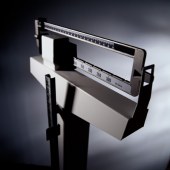- Skip Storing This Everyday Product in the Fridge Door
- Green Tea + B3 Pairing May Boost Brain Health
- Navigating Your Midlife Crisis: Embracing New Possibilities
- City Raccoons Showing Signs of Domestication
- Mapping the Exposome: Science Broadens Focus to Environmental Disease Triggers
- One Week Less on Social Media Linked to Better Mental Health
- Your Brain Changes in Stages as You Age, Study Finds
- Some Suicide Victims Show No Typical Warning Signs, Study Finds
- ByHeart Formula Faces Lawsuits After Babies Sickened With Botulism
- Switch to Vegan Diet Could Cut Your Greenhouse Gas Emissions in Half
Doctor-Implanted Balloons in Stomach May Spur Weight Loss


Balloons placed inside the stomach can trigger substantial weight loss without the need for invasive surgery, according to a new clinical trial.
The new device — two connected balloons filled with saline — helped obese people lose twice as much excess weight as others who relied on diet and exercise alone, said principal investigator Dr. Jaime Ponce. He is medical director of the bariatric surgery program at Hamilton Medical Center in Dalton, Ga. He is also a paid consultant to the company that manufacturers the device.
The balloons reduce stomach capacity, making people feel full with less food, Ponce said.
People with the balloons placed inside their stomachs lost 28.5 percent of their excess weight within six months, compared to 11.3 percent weight loss for those who tried the lifestyle changes.
Several weight loss experts were cautiously optimistic about the study findings. But at least one doctor wondered how permanent the weight loss might be.
The balloon device, called the ReShape Duo, is made by the southern California manufacturer ReShape Medical Inc., which sponsored the clinical trial. Ponce announced the results Tuesday at the annual meeting of the Obesity Society, in Boston. Data and conclusions presented at meetings are considered preliminary until published in a peer-reviewed medical journal.
Doctors insert the balloons through a scope snaked down the throat and into the stomach, and then fill them with saline containing a blue dye. It takes about eight minutes to place the balloons, and about 14 minutes to remove them, Ponce said.
Two connected balloons are used because earlier single-balloon versions tended to dislodge and migrate down the digestive tract, blocking the bowels, said Dr. Mitchell Roslin, chief of obesity surgery for Lenox Hill Hospital in New York City.
With the ReShape Duo, if one balloon ruptures, the other balloon will keep it in the stomach, Ponce said.
The patients’ urine will turn blue, alerting them to a rupture so doctors can go back in and retrieve the entire device. This occurred in about 6 percent of patients in the trial, with no migration into the bowel, Ponce said.
The trial included 326 patients whose body mass index (BMI) was between 30 and 40, which is considered obese. They were randomly assigned to either receive the balloons or undergo a “sham” endoscopic procedure.
Patients in both groups were required to participate in diet and exercise counseling for the length of the study and for six months afterwards.
Ponce said the balloons will fill a therapeutic gap for people who need to lose weight quickly but either don’t want weight-loss surgery or don’t qualify for it.
“The good news is we now have a new non-surgical therapy that allows patients to treat their obesity,” he said.
The temporary devices could help “jump start” weight loss for people who need to lose weight fast, said Dr. Ranjan Sudan, vice chair of education at the Duke University department of surgery.
For example, some people need to slim down rapidly to prepare for cardiac surgery or cancer treatment, but aren’t able to go through weight-loss surgeries such as gastric bypass or gastric banding, said Sudan, who is chair of the American Society for Metabolic and Bariatric Surgery’s research committee.
“For somebody of that sort, if you can give them a balloon and they get to a weight range where they can go on to other treatments, that will be very beneficial to them,” he said.
However, Roslin questioned how permanent the weight loss will be.
The balloons must be removed after six months, to reduce the risk of rupture and the risk of stomach ulcers formed by friction against the balloon. In the trial, researchers noted gastric ulcers in about 35 percent of patients, but said most were small and superficial.
“Perhaps the biggest question is what the long term value will be? There will be weight loss, but weight regain will occur when the device is removed,” Roslin said.
About 15 percent of patients in the trial had to have the device removed prematurely due to intolerance. People who receive the balloons often suffer from nausea or abdominal discomfort during the first three days, Ponce said. While most adapt, he said some become too miserable and need the balloons removed.
The U.S. Food and Drug Administration is weighing whether to approve ReShape Duo for use in the United States. The balloons have been available in Europe since 2011, where their average price is about $1,000, Ponce said.
More information
For more on weight-loss surgery, visit the U.S. National Institutes of Health.
Source: HealthDay
Copyright © 2025 HealthDay. All rights reserved.










